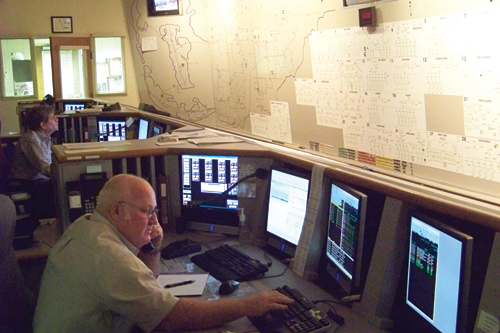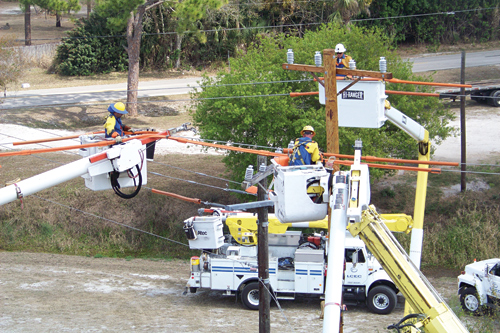Linemen live for emergency repairs. Along with emergency work, they also love scheduled overtime – the kind of job where they have to replace, for example, a transformer at a large shopping center. However, making the distribution of that work fair and equitable can be an ongoing challenge for utilities.
Economics can change the type and amount of work a utility has to accomplish, thus affecting schedules. Living in an area where summer storms can wreak havoc on electrical systems, necessitating a large amount of the workforce to report for emergency work, often confounds well-oiled schedules too. Other factors affecting the smooth scheduling and dispatching of linemen include limited – or a lack of – technology for determining the location of resources and order of callout. At times, technology creates unexpected consequences.
These challenges do not bring scheduling or dispatch to a complete halt or cause power restoration work to go unfinished, but they can delay the process, cost considerable time and money, and make it difficult for managers to get a global view of what is happening on their watch.
The process for scheduling and dispatch at Lee County Electric Cooperative (LCEC) has worked well. In fact, LCEC has always been able to maintain the approximately 8,000 miles of energized line it owns in Southwest Florida. However, there was room for improvement in the process for the supervisors and nearly 60 linemen and apprentices employed.
Scheduling Crews in a Changing Economy
In the last four years, among the biggest scheduling changes LCEC’s electric operations group has seen was the shift from a large amount of capital build-outs (i.e., expanding the LCEC infrastructure to accommodate for growth in Southwest Florida) to focusing, instead on internal projects. As we went through the economic downturn, LCEC had a sizable workforce working the 7 a.m. to 5 p.m. schedule, geared for completing the large demand for new service work and customer installations. Where we once had difficulty meeting customer demands to get a lineman on site, we now were having difficulty filling the schedules with work. We were also saddled with rising overtime costs and our measure for customer-related power outages, SAIDI (Sytem Average Interruption Duration Index), was on the rise.
We started by looking at our daily, monthly and annual workload. Ideally, we wanted to get most of our work done during the day, but we also needed to reduce the overtime burden and improve SAIDI. Our goal was to staff most efficiently to meet these competing demands. We reviewed data that we had on hand – types of work, available days and hours, and cycle-time on electrical lines that required service call outs.
Next, we arranged our shifts to be staggered throughout the day to best address those competing demands. Further, shifts were designed to change with the weather, so to speak, to meet the challenges of the higher callout rate during the summer. Ultimately, our analysis helped us restructure our shifts to obtain 24-hour coverage with 12 starting times. The result has been a significant decrease in LCEC’s overtime, and a sizable contribution to a 25 percent year-over-year decrease in the utility’s SAIDI since 2010.
Over time, LCEC has established a baseline for the number of line personnel needed to complete its forecasted workload for the year. We set up crew structures to complete the different types of work that are common in the industry. For instance, one type of structure is for larger crews handling infrastructure expansion, and another type is a one-man crew that troubleshoots or takes care of customer appointments.
We arranged the crews in shifts throughout the day, which provides flexibility in pairing up crews to complete work and to provide coverage for outages. We analyzed our callout activity, determined what hours were the most active and established shifts in these areas to handle that demand.
Like many utilities, LCEC relies on contractors as its flexible workforce. The utility expands and contracts those requests for help, depending upon the amount of work it faces at any given time. LCEC has supervisors who oversee the internal electric operations workforce and another group of managers who coordinate contractors.
LCEC schedules its contract workers to handle more of the engineer-designed and capital build-out projects; in general, LCEC has structured scheduling so that its contractors tackle the production work. By relying on its contractors to arrive at a jobsite to set poles and string wire, LCEC’s schedule isn’t impacted as much when linemen and supervisors are required to address service calls, attend company meetings or participate in training activities.
The LCEC electric operations group also has a crew, which it calls a “build-out crew,” which is designated for capital projects. This provides an additional crew at the ready for build-out projects when needed. LCEC linemen and apprentices are rotated in and out of the crew, so that their skills remain sharp.
Scheduling for Weather
The LCEC service territory covers a vast geographical area. In major storm-related restoration situations, the utility taps its internal supervisors to lead a team with both LCEC personnel and contractors. A typical crew for a catastrophic weather event would have a supervisor leading three LCEC personnel, three contractors, one runner who would handle mapping outages and damage, and a logistics coordinator to address equipment needs for the crew. Arranging housing, food and laundry for the crew is handled at another level of the organization, allowing the electric operations team to focus on restoration.
LCEC has pre-arranged disaster plans, each of which varies slightly depending on the timing and magnitude of the weather event (e.g., CAT 5 hurricane versus CAT 3). For each weather scenario, pre-determined levels of needs and methods for securing resources help to streamline the worker dispatching process.
Deploying Technology for Scheduling, Dispatch and Callout
Prior to 2010, LCEC relied on a system designed to dial line personnel when storms, power outages and other events struck. But the tool offered no reporting, metrics or analysis. That challenge was overcome in 2010 when LCEC implemented cloud-based software that automatically tracks the status of linemen. The automated crew-calling system, developed by ARCOS, Inc., also launches programmable callouts to bring linemen together in crews when needed and in compliance with LCEC rules and bargaining unit agreements.

Prior to implementing the automated crew callout system in 2010, we incurred several bargaining unit grievances each year, mainly due to errors in placing manual callouts, which in turn, have a negative financial impact on the organization. The ARCOS Suite gives LCEC supervisors and dispatchers a view of personnel on-site, personnel due on-site, linemen on sick leave and workers on vacation. It also enables LCEC to prepare long-term planning for crews and efficiently manage personnel leave.
Since implementing the new system, we have not had a single callout-related grievance filed. The system also provides up-to-the-minute, accurate statistics on callout, whereas our previous callout data collection was prone to errors, since LCEC compiled statistics manually. Moreover, the quality of the callout statistics has vastly improved and has become a useful tool throughout the organization.
By managing our callouts and scheduling with the automated system, our callout response from the linemen has also improved. The system also reports on LCEC’s turnout ratio for callout (i.e., the percentage of people we have answering calls). LCEC aspires to have a 33 percent turnout ratio on callout. When linemen are not meeting that threshold, we pull the data to show them both the callout goal and current performance and then discuss areas for improvement.
The LCEC electric operations team also uses a work management system to define work, schedule hours and track progress. Using an automated mapping and outage reporting system and geographic informtaion system (GIS), LCEC is able to extract data from the appropriate database. We then use another application for designing reports from the various data sources to see the details and timeframes of every outage. This helps LCEC supervisors identify when staffing or scheduling changes are needed.

When calls come into the LCEC outage management system, it records them and dispatchers determine the number of resources needed. If there is a shortage of linemen who can respond, LCEC schedulers turn to the callout system to see who is onsite and available to work. They can also use the ARCOS system to launch a callout. When a lineman calls in sick or takes an unplanned absence, the system captures this information, allowing resources to be adjusted accordingly.
Measuring Success
LCEC department metrics measure success across a number of areas including quick service installation dates, lighting repair turn-around and maintenance work. There are annual targets that supervisors and linemen must meet as part of that work. And, of course, LCEC measures itself on callout response. On a corporate level, all of the LCEC repair and maintenance work feeds into SAIDI, which is a company KPI (Key Performance Indicator).
Wringing Efficiency from Analysis and Automation
Without technology, LCEC would not have the ability to collect and analyze the data that allows for split-second, objective decisions about scheduling, dispatch and restoration. A utility can make decisions from the gut or because of the influence of a large customer, but those kinds of decisions can be problematic. For example, in any given year, we may have one bad week of outages across a stretch of afternoons. The outages are real, and they do affect customers, albeit a subset of the overall service area. This enhanced ability to analyze data allows LCEC supervisors to more easily identify and separate actual outage data from periodic system anomalies. In that case, it would not be prudent to change shift coverage as a result of those rare events since changing shift coverage for such reasons could possibly impact efficiency down the road.
Today, we have a much better baseline in place for decision-making than we did two years ago. We can notify line personnel within seconds of an outage and track their status until power is restored. In addition, we have the operational metrics to help us monitor response time and availability of linemen, which roll up into higher level metrics that measure the average outage duration for each customer.
About the Author
 Donald King is a senior supervisor for Electric Operations at Lee County Electric Cooperative. He is based in the utility’s North Fort Myers, Fla., operations center. King joined LCEC in 2004 as a senior supervisor in charge of contractor operations. Before that, he spent his career in the telecommunications industry handling around-the-clock, mission-critical operations. King received his bachelor’s degree from the University of Maryland, College Park.
Donald King is a senior supervisor for Electric Operations at Lee County Electric Cooperative. He is based in the utility’s North Fort Myers, Fla., operations center. King joined LCEC in 2004 as a senior supervisor in charge of contractor operations. Before that, he spent his career in the telecommunications industry handling around-the-clock, mission-critical operations. King received his bachelor’s degree from the University of Maryland, College Park.







